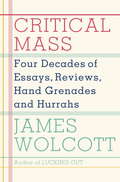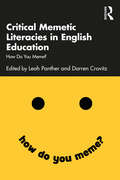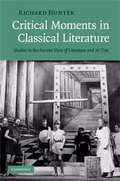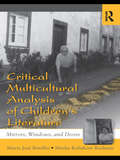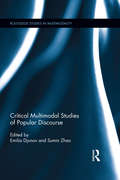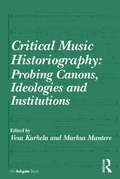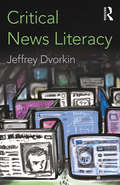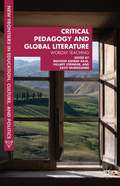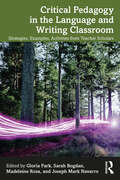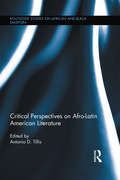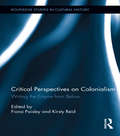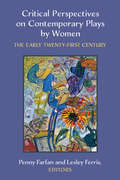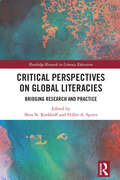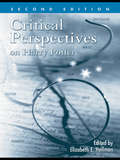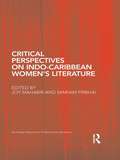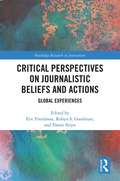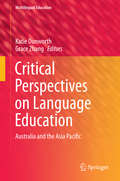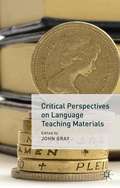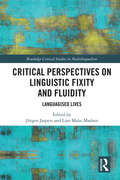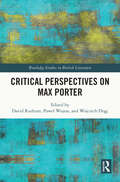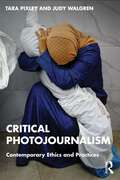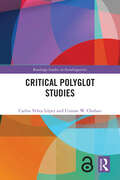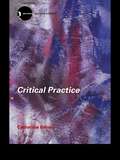- Table View
- List View
Critical Mass
by James WolcottA career-spanning collection of critical essays and cultural journalism from one of the most acute, entertaining, and sometimes acerbic (but in a good way) critics of our timeFrom his early-seventies dispatches as a fledgling critic for The Village Voice on rock 'n' roll, comedy, movies, and television to the literary criticism of the eighties and nineties that made him both feared and famous to his must-read reports on the cultural weather for Vanity Fair, James Wolcott has had a career as a freelance critic and a literary intellectual nearly unique in our time. This collection features the best of Wolcott in whatever guise--connoisseur, intrepid reporter, memoirist, and necessary naysayer--he has chosen to take on. Included in this collection is "O.K. Corral Revisited," a fresh take on the famed Norman Mailer-Gore Vidal dustup on The Dick Cavett Show that launched Wolcott from his Maryland college to New York City (via bus) to begin his brilliant career. His prescient review of Patti Smith's legendary first gig at CBGB leads off a suite of eyewitness and insider accounts of the rise of punk rock, while another set of pieces considers the vast cultural influence of the enigmatic Johnny Carson and the scramble of his late-night successors to inherit the "swivel throne." There are warm tributes to such diverse figures as Michael Mann, Sam Peckinpah, Lester Bangs, and Philip Larkin and masterly summings-up of the departed giants of American literature--John Updike, William Styron, John Cheever, and Mailer and Vidal. Included as well are some legendary takedowns that have entered into the literary lore of our time. Critical Mass is a treasure trove of sparkling, spiky prose and a fascinating portrait of our lives and cultural times over the past decades. In an age where a great deal of back scratching and softball pitching pass for criticism, James Wolcott's fearless essays and reviews offer a bracing taste of the real critical thing.
Critical Memetic Literacies in English Education: How Do You Meme?
by Darren Crovitz Leah PantherThis edited collection introduces English and literacy educators to the theoretical, research-based, and practical dimensions of using digital memetic texts—“memes”—in the classroom. Digital memetic texts come with new affordances, particularly as avenues for student creativity, voice, and advocacy. But these texts can also be put to manipulative, propagandistic, and nefarious purposes, posing critical challenges to an informed, democratic citizenry. Grounded in multimodality and critical literacy, this book investigates the fascinating digital dimension of texts, audiences, and meaning, and considers how English educators might take up these conversations in practical ways with students. With authentic examples from teachers and students, this volume provides a road map to researchers and educators—both preservice and in-service—interested in critical and productive uses of these modern phenomena.
Critical Moments in Classical Literature: Studies in the Ancient View of Literature and Its Uses
by Richard HunterThrough a series of innovative critical readings Richard Hunter builds a picture of how the ancients discussed the meaning of literary works and their importance in society. He pays particular attention to the interplay of criticism and creativity by not treating criticism in isolation from the works which the critics discussed. Attention is given both to the development of a history of criticism, as far as our sources allow, and to the constant recurrence of similar themes across the centuries. At the head of the book stands the contest of Aeschylus and Euripides in Aristophanes' Frogs which foreshadows more of the subsequent critical tradition than is often realised. Other chapters are devoted to ancient reflection on Greek and Roman comedy, to the Augustan critic Dionysius of Halicarnassus, to 'Longinus', On the Sublime, and to Plutarch. All Greek and Latin is translated.
Critical Multicultural Analysis of Children's Literature: Mirrors, Windows, and Doors (Language, Culture, and Teaching)
by Maria José Botelho Masha Kabakow Rudman<p>Critical multicultural analysis provides a philosophical shift for teaching literature, constructing curriculum, and taking up issues of diversity and social justice. It problematizes children’s literature, offers a way of reading power, explores the complex web of sociopolitical relations, and deconstructs taken-for-granted assumptions about language, meaning, reading, and literature: it is literary study as sociopolitical change. <p>Bringing a critical lens to the study of multiculturalism in children’s literature, this book prepares teachers, teacher educators, and researchers of children’s literature to analyze the ideological dimensions of reading and studying literature. Each chapter includes recommendations for classroom application, classroom research, and further reading. Helpful end-of-book appendixes include a list of children’s book awards, lists of publishers, diagrams of the power continuum and the theoretical framework of critical multicultural analysis, and lists of selected children’s literature journals and online resources.</p>
Critical Multimodal Studies of Popular Discourse: Critical Multimodal Studies Of Popular Discourse (Routledge Studies in Multimodality)
by Sumin Zhao Emilia Djonov Kay L. O'HalloranStudies of multimodality have significantly advanced our understanding of the potential of different semiotic resources—verbal, visual, aural, and kinetic—to make meaning and allow people to achieve various social purposes such as persuading, entertaining, and explaining. Yet little is known about the role that individual nonverbal resources and their interaction with language and with each other play in concealing and supporting, or drawing attention to and subverting, social boundaries and inequality, political or commercial agendas. This volume brings together contributions by rominent and emerging scholars that address this gap through the critical analysis of multimodality in popular culture texts and semiotic practices. It connects multimodal analysis to critical discourse analysis, demonstrating the value of different approaches to multimodality for building a better understanding of critical issues of central interest to discourse analysis, semiotics, applied linguistics, education, cultural and media studies.
Critical Music Historiography: Probing Canons, Ideologies and Institutions
by Markus Mantere Vesa KurkelaDuring the past two decades, there has emerged a growing need to reconsider the objects, axioms and perspectives of writing music history. A certain suspicion towards Francois Lyotard’s grand narratives, as a sign of what he diagnosed as our ’postmodern condition’, has become more or less an established and unquestioned point of departure among historians. This suspicion, at its most extreme, has led to a radical conclusion of the ’end of history’ in the work of postmodern scholars such as Jean Baudrillard and Francis Fukuyama. The contributors to Critical Music Historiography take a step back and argue that the radical view of the ’impossibility of history’, as well as the unavoidable ideology of any history, are counter-productive points of departure for historical scholarship. It is argued that metanarratives in history are still possible and welcome, even if their limitations are acknowledged. Foucault, Lyotard and others should be taken into account but systematized viewpoints and methods for a more critical and multi-faceted re-evaluation of the past through research are needed. As to the metanarratives of music history, they must avoid the pitfalls of evolutionism, hagiography, and teleology, all hallmarks of traditional historiography. In this volume the contributors put these methods and principles into practice. The chapters tackle under-researched and non-conventional domains of music history as well as rethinking older historiographical concepts such as orientalism and nationalism, and consequently introduce new concepts such as occidentalism and transnationalism. The volume is a challenging collection of work that stakes out a unique territory for itself among the growing body of work on critical music history.
Critical News Literacy
by Jeffrey Dvorkin<p>In an era of "fake news" and a seemingly insurmountable influx of data on the Internet, it is critical for both journalists and citizens to understand the digital media we consume daily. This introductory textbook gives students the tools they need to think critically about the news, and to see reliable news as an essential aspect of what it means to be an informed citizen in a democracy. <p>After reading this text, students will be able to: <p> <li>Analyze key elements of news reports by weighing evidence, evaluating sources, noting context and transparency to judge reliability. <li>Distinguish among journalism, informed opinion and unsupported opinions. <li>Identify and distinguish between news media bias and audience bias. <li>Use examples from the daily news media to show critical thinking about civic engagement. <li>Develop a skeptical and engaged approach to social media and digital technology.</li>
Critical Pedagogy And Global Literature
by Masood Ashraf Raja Hillary Stringer Zach VandezandeIn one volume, this edited collection provides both a theoretical and praxis-driven engagement with teaching world literature, focusing on various aspects of critical pedagogy. Included are nine praxis-driven essays by instructors who have taught world literature courses at the university level.
Critical Pedagogy in the Language and Writing Classroom: Strategies, Examples, Activities from Teacher Scholars
by Gloria Park Sarah Bogdan Madeleine Rosa Joseph Mark NavarroThis volume introduces theory-to-practice-based critical pedagogy grounded in Paulo Freire’s scholarship to language and literacy learning settings. The chapters present authentic experiences of teacher-scholars, feature real-world examples and activities ready for implementation in the classroom, and provide nuanced guidance for future teachers. The examples and activities from teacher-scholars place critical pedagogy at the heart of classroom contexts and cover key topics, including place-based pedagogy, contemplative pedagogy, technology within the classroom, and translingual and multimodal paradigms. The chapters include further readings and discussion questions that challenge assumptions and promote deeper reflection, and can be modified for different teaching contexts. This practical volume is essential reading for students and scholars in TESOL and critical pedagogy.
Critical Perspectives on Afro-Latin American Literature (Routledge Studies on African and Black Diaspora)
by Antonio D. TillisAfter generations of being rendered virtually invisible by the US academy in critical anthologies and literary histories, writing by Latin Americans of African ancestry has become represented by a booming corpus of intellectual and critical investigation. This volume aims to provide an introduction to the literary worlds and perceptions of national culture and identity of authors from Spanish-America, Brazil, and uniquely, Equatorial Guinea, thus contextually connecting Africa to the history of Spanish colonization. The importance of Latin America literature to the discipline of African Diaspora studies is immeasurable, and this edited collection provides a ripe cultural context for critical comparative analysis among the vast geographies that encompass African and African Diaspora studies. Scholars in the area of African Diaspora Studies, Black Studies, Latin American Studies, and American literature will be able to utilize the eleven essays in this edition to enhance classroom instruction and further academic research.
Critical Perspectives on Colonialism: Writing the Empire from Below (Routledge Studies in Cultural History)
by Fiona Paisley Kirsty ReidThis collection brings much-needed focus to the vibrancy and vitality of minority and marginal writing about empire, and to their implications as expressions of embodied contact between imperial power and those negotiating its consequences from "below." The chapters explore how less powerful and less privileged actors in metropolitan and colonial societies within the British Empire have made use of the written word and of the power of speech, public performance, and street politics. This book breaks new ground by combining work about marginalized figures from within Britain as well as counterparts in the colonies, ranging from published sources such as indigenous newspapers to ordinary and everyday writings including diaries, letters, petitions, ballads, suicide notes, and more. Each chapter engages with the methodological implications of working with everyday scribblings and asks what these alternate modernities and histories mean for the larger critique of the "imperial archive" that has shaped much of the most interesting writing on empire in the past decade.
Critical Perspectives on Contemporary Plays by Women: The Early Twenty-First Century
by Lesley Ferris Penny FarfanThis book foregrounds some of the ways in which women playwrights from across a range of contexts and working in a variety of forms and styles are illuminating the contemporary world while also contributing to its reshaping as they reflect, rethink, and reimagine it through their work for the stage. The book is framed by a substantial introduction that sets forth the critical vision and structure of the book as a whole, and an afterword that points toward emerging currents in and expansions of the contemporary field of playwriting by women on the cusp of the third decade of the twenty-first century. Within this frame, the twenty-eight chapters that form the main body of the book, each focusing on a single play of critical significance, together constitute a multifaceted, inevitably partial, yet nonetheless integral picture of the work of women playwrights since 2000 as they engage with some of the most pressing issues of our time. Some of these issues include the continuing oppression of and violence against women, people of color, LGBTQ+ people, and ethnic minorities; the ongoing processes of decolonization; the consequences of neoliberal capitalism; the devastation and enduring trauma of war; global migration and the refugee crisis; the turn to right-wing populism; and the impact of climate change, including environmental disaster and species extinction. The book is structured into seven sections: Replaying the Canon; Representing Histories; Staging Lives; Re-imagining Family; Navigating Communities; Articulating Intersections; and New World Order(s). These sections group clusters of plays according to the broad critical actions they perform or, in the case of the final section, the new world orders that they capture through their stagings of the seeming impasse of the politically and environmentally catastrophic global present moment. There are many other points of resonance among and across the plays, but this seven-part structure foregrounds the broader actions that drive the plays, both in the Aristotelian dramaturgical sense and in the larger sense of the critical interventions that the plays creatively enact. In this way, the seven-part structure establishes correspondences across the great diversity of dramatic material represented in the book while at the same time identifying key methods of critical approach and areas of focus that align the book’s contributors across this diversity. The structure of the book thus parallels what the playwrights themselves are doing, but also how the contributors are approaching their work. Plays featured in the book are from Canada, Australia, South Africa, the US, the UK, France, Argentina, New Zealand, Syria, Brazil, Italy, and Austria; the playwrights include Margaret Atwood, Leah Purcell, Yaël Farber, Paula Vogel, Adrienne Kennedy, Suzan-Lori Parks, debbie tucker green, Lisa Loomer, Hélène Cixous, Anna Deavere Smith, Lola Arias, Lisa Kron and Jeanine Tesori, Marie Clements, Quiara Alegría Hudes, Alia Bano, Holly Hughes, Whiti Hereaka, Julia Cho, Liwaa Yazji, Grace Passô, Dominique Morisseau, Emma Dante, Frances Ya-Chu Cowhig, Lynn Nottage, Elfriede Jelinek, Caryl Churchill, Colleen Murphy, and Lucy Kirkwood. Encompassing several generations of playwrights and scholars, ranging from the most senior to mid-career to emerging voices, the book will be essential reading for established researchers, a valuable learning resource for students at all levels, and a useful and accessible guide for theater practitioners and interested theater-goers.
Critical Perspectives on Global Literacies: Bridging Research and Practice (Routledge Research in Literacy Education)
by Shea N. Kerkhoff Hiller A. SpiresThis book offers critical perspectives on global literacies, connecting research, theory, and practice. An emerging concept in the literacy field, many scholars agree on the need for students to develop global literacies, yet few agree on a widely accepted definition. Based on a synthesis of the literature, the editors formulate a definition of global literacies with four dimensions, including: literacy as a human right in all nations around the world; critical reading and creation of multimodal texts about global issues; intercultural communication and reciprocal collaboration with globally diverse others; and transformative action for social and environmental justice that traverses borders. Taking this shared, proposed definition as a starting point, the chapters then offer contextualized examples of global literacies from K-12 and teacher education classrooms to make explicit links between research and practice. The contributors interact with and interrogate the book’s definition of global literacies using a common framework of critical theory. As such, this book provides both emerging and established scholars with critical frameworks for positioning global literacies in ways that are relevant, dynamic, and forward thinking.
Critical Perspectives on Harry Potter
by Elizabeth E. HeilmanThis thoroughly revised edition includes updated essays on cultural themes and literary analysis, and its new essays analyze the full scope of the seven-book series as both pop cultural phenomenon and as a set of literary texts. Critical Perspectives on Harry Potter, Second Edition draws on a wider range of intellectual traditions to explore the texts, including moral-theological analysis, psychoanalytic perspectives, and philosophy of technology. The Harry Potter novels engage the social, cultural, and psychological preoccupations of our times, and Critical Perspectives on Harry Potter, Second Edition examines these worlds of consciousness and culture, ultimately revealing how modern anxieties and fixations are reflected in these powerful texts. ("DISCLAIMER: This book is not authorized, approved, licensed, or endorsed by J.K. Rowling, Warner Bros. Entertainment Inc., or anyone associated with the Harry Potter books or movies.")
Critical Perspectives on Indo-Caribbean Women's Literature (Routledge Research in Postcolonial Literatures #41)
by Joy Mahabir Mariam PirbhaiThis book is the first collection on Indo-Caribbean women's writing and the first work to offer a sustained analysis of the literature from a range of theoretical and critical perspectives, such as ecocriticism, feminist, queer, post-colonial and Caribbean cultural theories. The essays not only lay the framework of an emerging and growing field, but also critically situate internationally acclaimed writers such as Shani Mootoo, Lakshmi Persaud and Ramabai Espinet within this emerging tradition. Indo-Caribbean women writers provide a fresh new perspective in Caribbean literature, be it in their unique representations of plantation history, anti-colonial movements, diasporic identities, feminisms, ethnicity and race, or contemporary Caribbean societies and culture. The book offers a theoretical reading of the poetics, politics and cultural traditions that inform Indo-Caribbean women's writing, arguing that while women writers work with and through postcolonial and Caribbean cultural theories, they also respond to a distinctive set of influences and realities specific to their positioning within the Indo-Caribbean community and the wider national, regional and global imaginary. Contributors visit the overlap between national and transnational engagements in Indo-Caribbean women's literature, considering the writers' response to local or nationally specific contexts, and the writers' response to the diasporic and transnational modalities of Caribbean and Indo-Caribbean communities.
Critical Perspectives on Journalistic Beliefs and Actions: Global Experiences (Routledge Research in Journalism)
by Eric Freedman Robyn S. Goodman Elanie SteynThis book provides case studies, many incorporating in-depth interviews and surveys of journalists. It examines issues such as journalists’ attitudes toward their contributions to society; the impact of industry and technological changes; culture and minority issues in the newsroom and profession; the impact of censorship and self-censorship; and coping with psychological pressures and physical safety dilemmas. Its chapters also highlight journalists’ challenges in national and multinational contexts. International scholars, conducting research within a wide range of authoritarian, semi-democratic, and democratic systems, contributed to this examination of journalistic practices in the Arab World, Australia, Bangladesh, Bulgaria, China, Denmark, India, Kenya, Kyrgyzstan, Malaysia, Mexico, Russia, Samoa, South Africa, Taiwan, Turkey, and the United States.
Critical Perspectives on Language Education: Australia and the Asia Pacific (Multilingual Education #11)
by Katie Dunworth Grace ZhangThe studies in this volume investigate how multilingual education involves a critical engagement with questions of identity and culture, and a movement towards new ways of being and belonging. It addresses previously under-explored issues, in particular the integration of theories like 'thirdness', and practices of language education and maintenance with relevance to the Asia-Pacific region. The analyses reveal the delicate balance of interests of all stakeholders and offer detailed insights into the reality of multilingual education, with specific examples of Chinese, English, Japanese and Tamil. In a globalised world, effective language education has become increasingly important, and the studies presented here have the potential to inform and advance evidence-based multilingual education through adding important dimensions of theoretical exploration and refreshing empirical resources.
Critical Perspectives on Language Teaching Materials
by John GrayThis Critical Perspectives on Language Teaching Materials brings together a collection of critical voices on the subject of language teaching materials for use in English, French, Spanish, German and Content and Language Integrated Learning (CLIL) classrooms.
Critical Perspectives on Linguistic Fixity and Fluidity: Languagised Lives (Routledge Critical Studies in Multilingualism)
by Lian Malai Madsen Jürgen JaspersThis volume offers a critical perspective on current views on linguistic fixity and fluidity in sociolinguistics and highlights empirical accounts alternative to prevailing trends in the field. Featuring accounts from a broad range of regional contexts, the collection takes stock of such terms as "polylingualism", "metrolingualism" and "translanguaging" to question perceptions around multilingual and monolingual language use. The book critiques the status of fluid language use as a more "natural" language practice and in turn, its greater potential for corresponding social transformation, demonstrating the value of linguistic fixity and the continuous debate between fixity and fluidity in multilingual speakers' lives. In providing these accounts, the book seeks not to advocate for linguistic fixity or fluidity, but to argue that sociolinguists pay close attention to the way both types of linguistic practice open up or close down avenues for social transformation. This collection is a key reading for graduate students and scholars in sociolinguistics, multilingualism, and linguistic anthropology.
Critical Perspectives on Max Porter (Routledge Studies in British Literature)
by David Rudrum Paweł Wojtas Wojciech DrągMax Porter is amongst the most exciting British writers of the twenty-first century. His striking books straddle the divide between poetry and prose as deftly as they combine literary experimentation with mainstream success. This book is the first study of his works to date, which encompass Grief Is the Thing with Feathers (2015), Lanny (2019), The Death of Francis Bacon (2021) and Shy (2023). It features a broad interdisciplinary array of essays (by poets, novelists, literary critics, art historians and educationalists), which collectively place Porter’s works in their contexts, shed light on his artistic vision and interpret his texts from a range of critical perspectives. The volume’s 12 chapters combine readings of the literary, formal, intertextual and experimental aspects of Porter’s works with discussions of their relation to social, political and ethical questions, whilst placing them in dialogue with highly topical critical and cultural debates, such as Englishness in the aftermath of Brexit, ecocriticism, affectivity and posthumanism.
Critical Photojournalism: Contemporary Ethics and Practices
by Judy Walgren Tara PixleyAn essential introduction to the complexities of visual representation, this book offers a critical new framework for understanding and practicing photojournalism in a global digital context.Critical Photojournalism guides readers through a variety of ethical, technical and business skills, plus the mental health, self-care and safety considerations necessary to thrive in the field. Drawing on their extensive industry and teaching experience, the authors provide real-world advice on how to navigate the demands of the profession while addressing the impact that photojournalism has on society and ways that photojournalists can mitigate harm. Consideration is given to understanding and disrupting implicit bias and power structures in newsrooms, as well as issues around access, working in breaking news environments and balancing informed consent with varying media laws around the world. In accessible language, this book highlights the importance of collaboration and community engagement in contemporary photojournalism and encourages students to adopt a decolonial approach to their work. Readers will learn to balance the needs for accuracy and thoughtfulness with the priorities of a global, social-media-engaged audience.This is a key textbook for those seeking a nuanced introduction to visual journalism and/or a fresh approach to their craft. This book is supported by a website which can be accessed at www.criticalphotojournalism.com. The website includes a full-length bonus chapter on video and photojournalism, interviews with professional visual journalists, further tips and tools, and a glossary of key terms.
Critical Poetics of Feminist Refusals: Voicing Dissent Across Differences (Literary Criticism and Cultural Theory)
by Federica BuetiCritical Poetics of Feminist Refusals renders a vivid portrait of the intergenerational and intersectional dialogue between influential feminist writers on how to say no to the conditions of oppression, exclusion, and exploitation imposed by patriarchal and systemically racist capitalist societies. The book provides today’s readers and writers access to the powerful inventory of concepts and techniques that two generations of feminists have assembled for refusing domination and constituting fugitive forms of sociability and writing. Drawing on examples from feminist thinkers, Audre Lorde, Carla Lonzi, Hélène Cixous, Hortense Spillers, Alexis Pauline Gumbs, Anne Boyer and Simone White, the book focuses on how the power dynamics of recognition tie the uses of language to the material conditions of discrimination in everyday life.
Critical Polyglot Studies (Routledge Studies in Sociolinguistics)
by Carlos Yebra López Usman ChohanThis book offers a self-reflective, critical approach to the study of what is popularly known as polyglossia, charting the gradual but marked process of its commoditization over the last 20 years and offering a counterpoint to mainstream positivist treatment of serial language learning.First, from a diagnostic standpoint, the book examines the rise and consolidation of the Polyglot Community in the sociopolitical and economic context of its gradual transformation into and partial overlap with the Polyglot Industry and its ideological tenets (the Polyglot Matrix). Second, from a prognostic standpoint, the book posits Critical Polyglot Studies (CPS) as a much-needed counter to the many theoretical and practical shortcomings of the Polyglot Industry-cum-Matrix, presenting the main programmatic points and illustrative best practices and institutional case studies of this alternative paradigm. CPS is conceived as both a research orientation and as a strategic attempt to elicit debate and draw in a wider range of polyglossia scholars, offering readers with actionable tools to contribute to this emerging academic and activist endeavor.Constituting the first critical and systematic analysis of polyglossia as a globalized phenomenon, this book will be of interest to scholars of linguistics, cultural studies, critical theory, and sociology.Chapter 3 of this book is freely available as a downloadable Open Access PDF at http://www.taylorfrancis.com under a Creative Commons Attribution-NonCommercial-NoDerivatives (CC-BY-NC-ND) 4.0 International license.
Critical Practice
by Catherine BelseyWhat is poststructuralist theory, and what difference does it make to literary criticism? Where do we find the meaning of the text: in the author's head? in the reader's? Or do we, instead, make meaning in the practice of reading itself? If so, what part do our own values play in the process of interpretation? And what is the role of the text? Catherine Belsey considers these and other questions concerning the relations between human beings and language, readers and texts, writing and cultural politics. Assuming no prior knowledge of poststructuralism, Critical Practice guides the reader confidently through the maze of contemporary theory. It simply and lucidly explains the views of key figures such as Louis Althusser, Roland Barthes, Jacques Lacan and Jacques Derrida, and shows their theories at work in readings of familiar literary texts. Critical Practice argues that theory matters, because it makes a difference to what we do when we read, opening up new possibilities for literary and cultural analysis. Poststructuralism, in conjunction with psychoanalysis and deconstruction, makes radical change to the way we read both a priority and a possibility. With a new chapter, updated guidance on further reading and revisions throughout, this second edition of Critical Practice is the ideal guide to the present and future of literary studies.
Critical Practice
by Katherine BelseyWhat is poststructuralist theory, and what difference does it make to literary criticism? Where do we find the meaning of the text: in the author's head? in the reader's? Or do we, instead, make meaning in the practice of reading itself? If so, what part do our own values play in the process of interpretation? And what is the role of the text? Catherine Belsey considers these and other questions concerning the relations between human beings and language, readers and texts, writing and cultural politics. Critical Practice assumes no prior knowledge of poststructuralism, but guides the reader confidently through the maze of contemporary theory. The volume simply and lucidly explains the views of such key figures as Louis Althusser, Roland Barthes, Jacques Lacan and Jacques Derrida, and shows their theories at work in readings of familiar literary texts.
